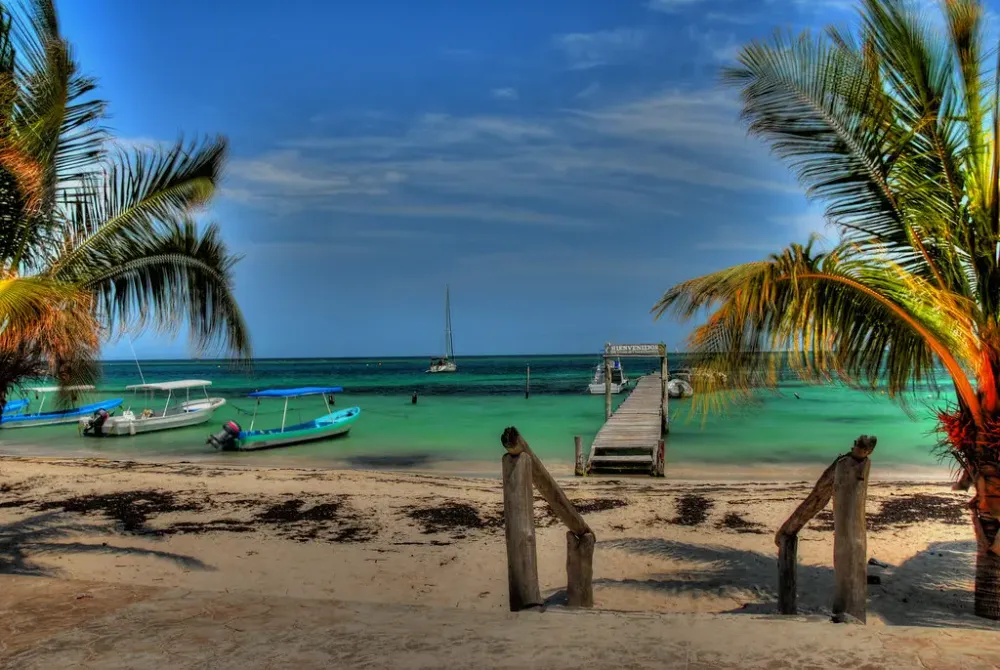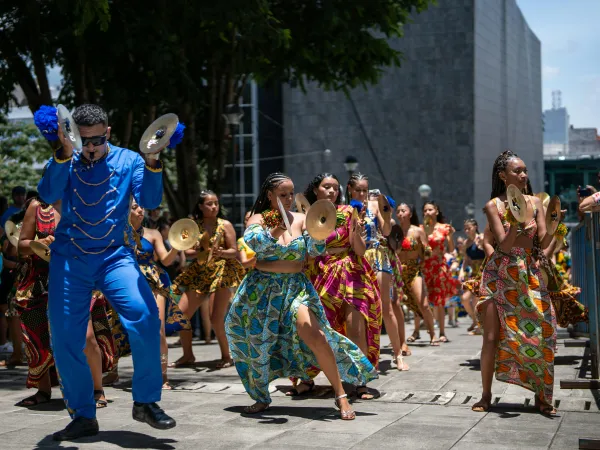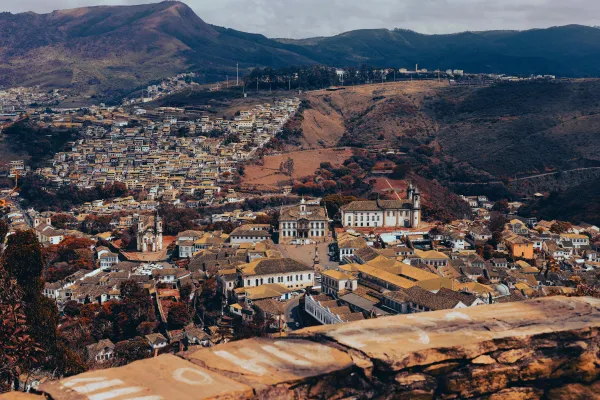13 Things To Do In Puerto Morelos, The Quiet Beach
Tucked between Cancún and Playa del Carmen, Puerto Morelos has always been more than a stop on the Riviera Maya. Long before tourists discovered its quiet beaches, this was a fishing village tied to the rhythms of the sea and the sacred landscapes of the Yucatán. The Maya relied on the surrounding jungle for medicine and food, and on the cenotes—those deep limestone sinkholes—for survival and ritual. Offshore, the reef provided sustenance and protection, forming part of the vast Mesoamerican Barrier Reef system that shaped life along this coast.
By the 20th century, Puerto Morelos grew into a modest port town, supplying chicle for chewing gum and serving as a gateway to inland communities. Hurricanes battered its shore, yet each time the town rebuilt, holding fast to its identity as a place of resilience and tradition. When tourism spread down the Riviera Maya in the late 20th century, Puerto Morelos charted its own course. Instead of sprawling resorts, it offered a quieter path—eco-parks, botanical gardens, cenotes hidden in the jungle, and community markets where artisans carried forward ancient crafts.
This guide uncovers 13 places to visit in Puerto Morelos, each one tied to a larger story.
1. Croco Cun Zoo
Important Information
- Fun Fact: A unique interactive zoo where visitors can walk among crocodiles, feed monkeys, and learn about local wildlife conservation.
- Address: Carretera Cancún–Tulum, km 31, Puerto Morelos, Q.R., Mexico
- Best time to visit: Morning to see active animals and avoid midday heat.
- Distance to city center: About 3 miles north of Puerto Morelos town.
- Pricing: Adults $35 USD; children (6–12) $25 USD; under 6 free.
- Parking: Free on-site parking.
- Accessibility: Mostly accessible trails; some uneven paths.
- Opening Hours: Daily 9 a.m.–4:30 p.m.
- Closing Hours: 4:30 p.m.
- Discounts / Deals: Family packages and online booking discounts.
Founded in the 1980s as a crocodile farm, Croco Cun Zoo has transformed into one of Puerto Morelos’ most engaging conservation experiences. What began as a breeding facility gradually shifted into a sanctuary after a hurricane nearly destroyed the farm in the late 1980s. Instead of rebuilding for commerce, the owners reimagined the site as a space for education, preservation, and close encounters with native wildlife.
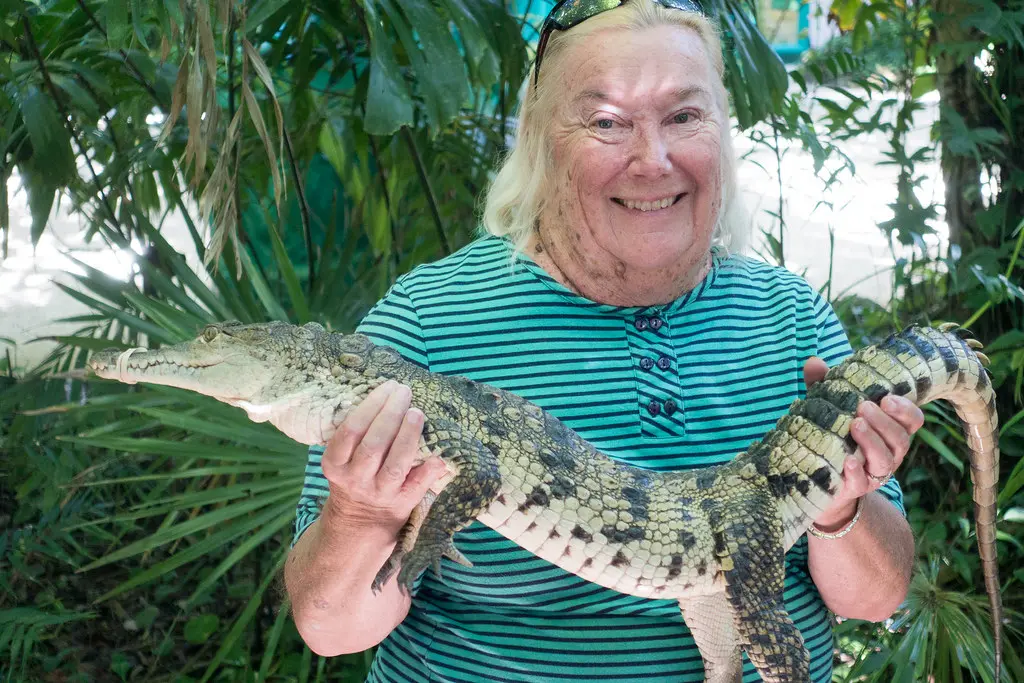
The zoo’s story reflects a broader shift in the Yucatán Peninsula—from exploitation of natural resources to active conservation. Over the years, it has grown into a living classroom where visitors walk among free-roaming animals and learn about the delicate ecosystems of Quintana Roo. From spider monkeys swinging through the canopy to brightly colored macaws and the iconic crocodiles basking in the sun, each encounter carries the weight of the zoo’s origins and its dedication to protecting species once threatened by trade and habitat loss.
⭐⭐⭐⭐⭐ - Becki Davidson
Excellent attraction! It was a wonderful experience and we learnt so much! We got to walk through a crocodile enclosure, hold a snake, feed some animals and hold a tiny crocodile! The tour lasted about 45 mins which was perfect in the summer heat! There is a small playground at the end and a large gift shop.
2. Monumento Ruta de los Cenotes
Important Information
- Fun Fact: A symbolic gateway marking the start of the famous "Cenote Route," leading to over a dozen natural sinkholes.
- Address: Carretera Puerto Morelos–Leona Vicario, Puerto Morelos, Q.R., Mexico
- Best time to visit: Morning for photos before the crowds arrive.
- Distance to city center: About 2 miles west of Puerto Morelos.
- Pricing: Free.
- Parking: Free roadside parking.
- Accessibility: Accessible viewpoint.
- Opening Hours: Open daily, 24 hours.
- Closing Hours: None.
- Discounts / Deals: Free attraction.
Standing at the edge of the jungle roads that lead inland from Puerto Morelos, the Monumento Ruta de los Cenotes serves as a symbolic gateway to one of the Yucatán’s most remarkable landscapes. This monument was erected to mark the route connecting dozens of cenotes—natural sinkholes formed over thousands of years in the porous limestone of the peninsula. For the ancient Maya, cenotes were sacred portals to the underworld, sources of fresh water, and sites of ritual offerings.
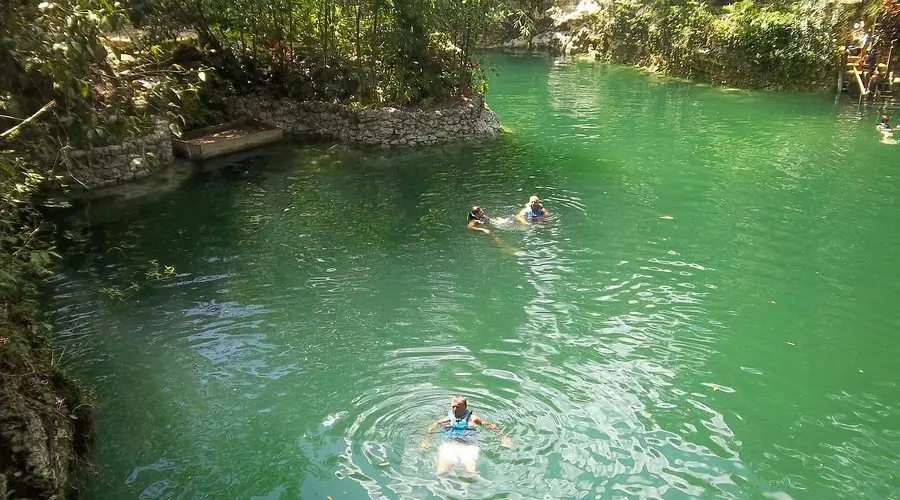
The monument, simple yet meaningful, reminds travelers that they are entering a corridor of both geological wonder and cultural memory. Each cenote along this road tells its own story—some hidden deep in the jungle, others easily accessible—but together they form a chain that has shaped settlement, survival, and spirituality in the region.
By highlighting the Ruta de los Cenotes, the monument links modern adventure tourism with centuries of tradition. It encourages visitors to see beyond swimming and diving, and to recognize these pools as vital threads in the tapestry of Mayan civilization. As such, it stands not only as a marker on the roadside, but as a bridge between past reverence and present exploration.
⭐⭐⭐⭐⭐ - Christian Rivera
We went to Cenote Zapote. 4 total centotes. Two on-site and 2, you will have to drive 5 min. Buy tickets online
3. Playa Pública Puerto Morelos
Important Information
- Fun Fact: A calm, family-friendly public beach known for turquoise water, soft white sand, and the leaning lighthouse—an iconic landmark.
- Address: Av. Rafael E. Melgar, Puerto Morelos, Q.R., Mexico
- Best time to visit: Morning or sunset for the best light and fewer crowds.
- Distance to city center: Located in downtown Puerto Morelos.
- Pricing: Free access.
- Parking: Free and paid parking nearby.
- Accessibility: Beach ramps and accessible areas available.
- Opening Hours: Open daily, 24 hours.
- Closing Hours: None.
- Discounts / Deals: Free entry year-round.
The public beach of Puerto Morelos has always been more than a stretch of sand—it is the heart of the town’s coastal life. Long before the resorts rose along the Riviera Maya, this shoreline served as a landing point for fishermen who set out each morning in wooden boats to harvest the Caribbean’s waters. The pier and waterfront became the lifeblood of the community, a place where daily work, social gatherings, and spiritual connection with the sea intertwined.
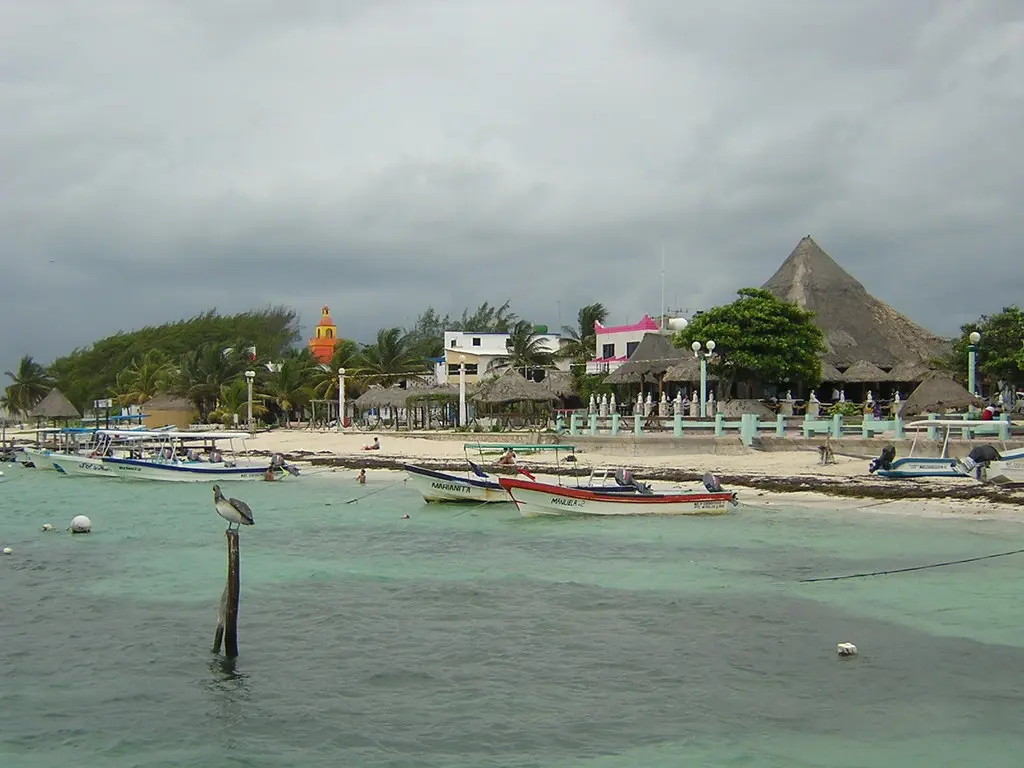
Over the years, Playa Pública has remained central even as Puerto Morelos evolved from a quiet fishing village into a sought-after destination. Locals still gather here for festivals, families share picnics under palm trees, and visitors step into the same waters that sustained generations. The reef visible just offshore, part of the Mesoamerican Barrier Reef system, has shaped both the culture and the livelihood of this coast. From colonial times to the rise of modern tourism, the beach has anchored Puerto Morelos as a meeting point between land and sea.
Walking along its sands today is to follow in the footsteps of centuries of coastal life—a reminder that the town’s growth has always begun at the water’s edge.
⭐⭐⭐⭐⭐ - Anne Bradley
This is our 4th time visiting the area as it is a direct flight from Edmonton, Alberta-a great escape when the winter gets too long.We come here for the wonderful open water swimming as the reef keeps the big waves away. Renting an apartment allows us to purchase fresh seafood and vegetables to prepare. We have done some great outings to Tulum, the cenotes, and other Mayan ruins in the area. We rented bikes and explored the area. You can get around on foot or use local transportation. Love this friendly village and people!
4. Jardín Botánico Dr. Alfredo Barrera Marín
Important Information
- Fun Fact: One of Mexico’s largest botanical gardens, featuring jungle trails, mangroves, and over 300 native plant species.
- Address: Carretera Cancún–Tulum, km 31, Puerto Morelos, Q.R., Mexico
- Best time to visit: Morning for shade and wildlife spotting.
- Distance to city center: About 2.5 miles west of Puerto Morelos.
- Pricing: Adults $5 USD; children under 12 free.
- Parking: Free on-site parking.
- Accessibility: Moderate; trails can be uneven.
- Opening Hours: Monday–Friday 8 a.m.–4 p.m.
- Closing Hours: 4 p.m.
- Discounts / Deals: Student and senior discounts available.
Established in 1982, the Jardín Botánico Dr. Alfredo Barrera Marín is one of the largest botanical gardens in Mexico, covering more than 160 hectares of coastal jungle. Its creation marked an important step in environmental preservation, at a time when development along the Riviera Maya was beginning to accelerate. Named for the renowned Mexican botanist, the garden was designed to safeguard the region’s native flora while offering a space for research, education, and cultural reflection.
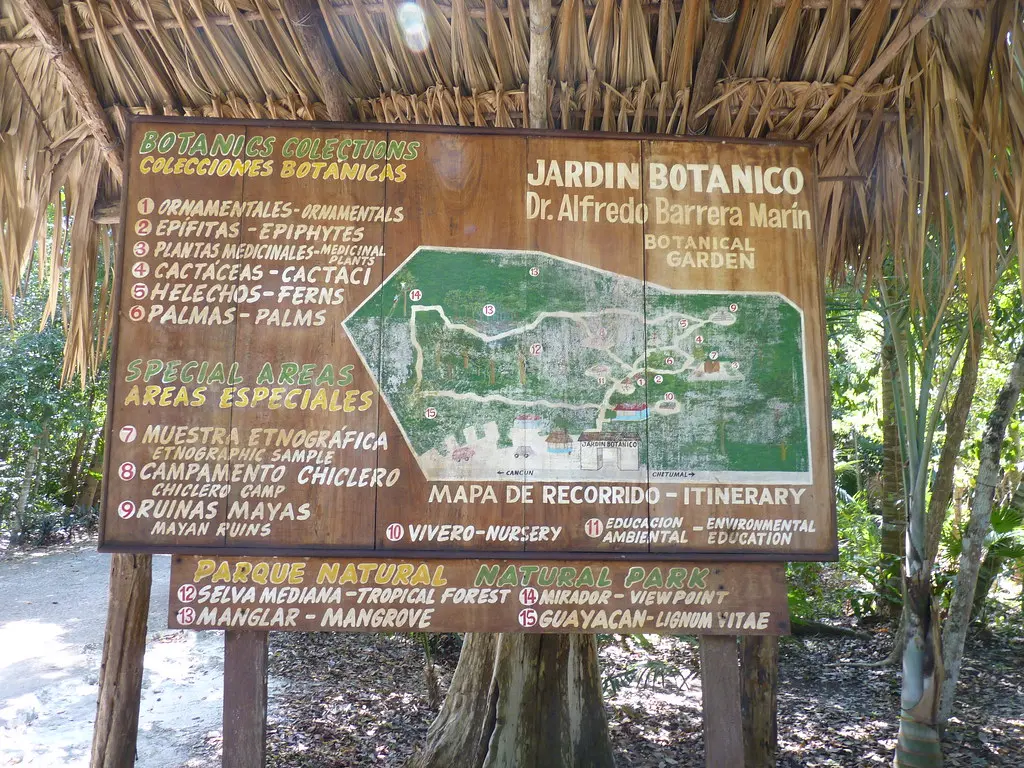
What makes this garden especially meaningful is its connection to both nature and history. Within its grounds are remnants of ancient Mayan structures, reminders that this forest once supported communities who relied on its medicinal plants, hardwoods, and sacred trees. Trails wind through mangroves, cactus groves, and towering ceiba trees, long considered sacred in Mayan cosmology as the link between earth and sky.
For over four decades, the garden has balanced ecological protection with cultural storytelling. It stands as a living archive of the Yucatán’s biodiversity and heritage, offering visitors more than beauty—it provides a window into the intertwined history of people and landscape. In Puerto Morelos, few places capture the region’s past and future as fully as this botanical sanctuary.
⭐⭐⭐⭐⭐ - Richard Passey
Beautiful nature preserve amidst Mayan ruins. In the jungle (use mosquito repellent) and next to the mangroves. Great hike great trail, great viewing platform. And education and conservation minded as well. We loved this experience.
5. National Reef Park of Puerto Morelos
Important Information
- Fun Fact: Part of the Mesoamerican Barrier Reef System, this protected marine park is perfect for snorkeling and diving with tropical fish and corals.
- Address: Off the coast of Puerto Morelos, accessible by boat tours.
- Best time to visit: Morning for calm seas and best visibility.
- Distance to city center: Departures from the main pier in downtown Puerto Morelos.
- Pricing: Boat tours from $25–$40 USD per person.
- Parking: Paid parking near the pier.
- Accessibility: Boat access only; not fully accessible.
- Opening Hours: Daily 8 a.m.–5 p.m.
- Closing Hours: 5 p.m.
- Discounts / Deals: Discounts for group bookings and local residents.
Created in 1998, the National Reef Park of Puerto Morelos protects one of the most vital stretches of the Mesoamerican Barrier Reef, the second-largest reef system in the world. Long before it became a national park, these shallow waters sustained the fishing community of Puerto Morelos, providing both food and trade. For the Maya, the reef and its lagoons were part of a sacred seascape, tied to navigation, offerings, and survival along the coast.
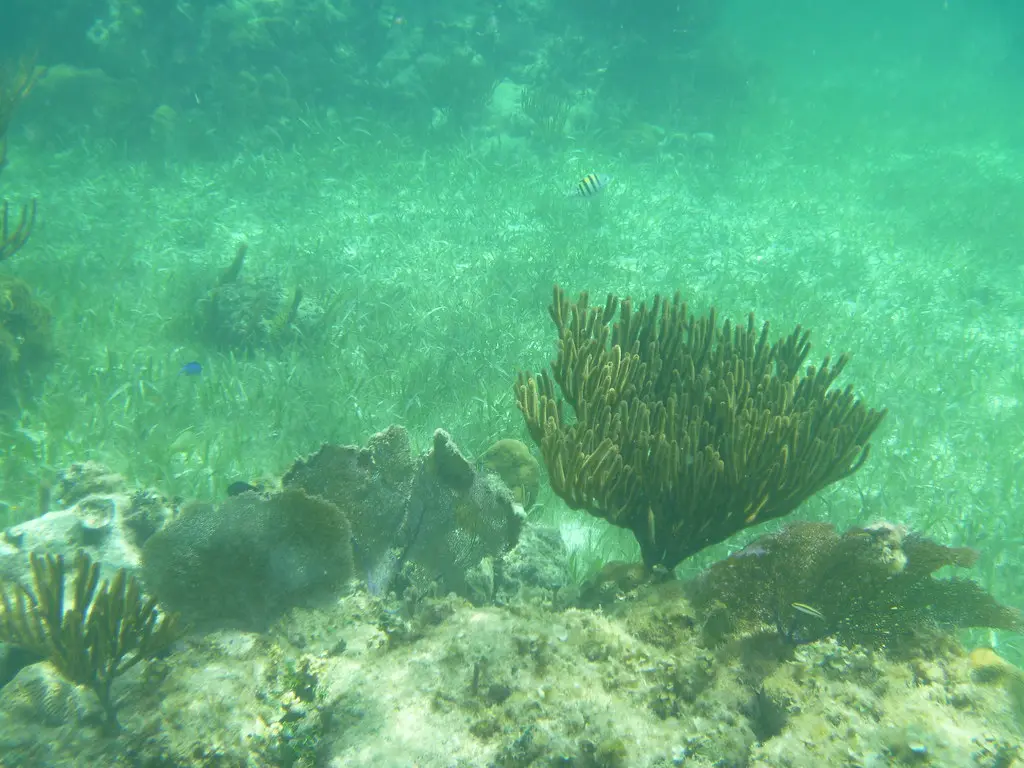
The park’s establishment reflected a turning point in local history. As tourism surged in the late 20th century, reefs once used for sustenance faced threats from overfishing, pollution, and unregulated diving. Community leaders and scientists worked together to secure federal protection, ensuring that future generations could continue to experience the reef’s beauty and biodiversity.
Today, the park is not just a natural wonder but a cultural milestone. Fishermen who once cast nets here now serve as guides, leading snorkelers and divers through coral gardens where parrotfish, turtles, and rays still thrive. The reef tells a story of adaptation—how a town once dependent on extraction embraced preservation, turning a fragile ecosystem into its most enduring treasure.
⭐⭐⭐⭐⭐ - H O
It is different feeling to watch reefs and sea life under water. Great experience of snorkeling here. Second biggest reef in the world. There are boats that take you where reefs are. You can book snorkeling tour around Puerto Morelos sign.
6. Mercado de Artesanías Puerto Morelos
Important Information
- Fun Fact: A colorful local market filled with handcrafted souvenirs, textiles, jewelry, and traditional Mexican art from regional artisans.
- Address: Av. Javier Rojo Gómez, Puerto Morelos, Q.R., Mexico
- Best time to visit: Morning to mid-afternoon when all stalls are open.
- Distance to city center: In downtown Puerto Morelos.
- Pricing: Free entry; items range from $5–$100 USD.
- Parking: Street and nearby paid parking available.
- Accessibility: Accessible walkways and vendor stalls.
- Opening Hours: Daily 9 a.m.–6 p.m.
- Closing Hours: 6 p.m.
- Discounts / Deals: Bargaining welcome; discounts for multiple purchases.
The Mercado de Artesanías Puerto Morelos, though modest in size, represents a deep thread in Mexican history—the tradition of local markets as centers of community and culture. Markets have been gathering places since pre-Hispanic times, where goods, stories, and customs were exchanged. While this market is relatively new, opening in the late 20th century, it carries that same spirit in a modern coastal town.
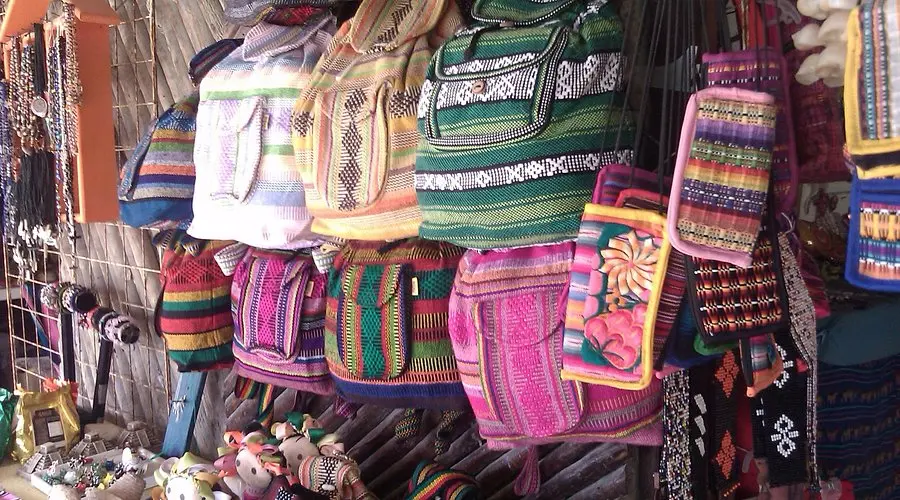
Stalls overflow with handwoven textiles, pottery, carved wood, and jewelry crafted by artisans from across the Yucatán and beyond. Each item connects visitors to centuries of craft passed down through families, techniques preserved from Mayan weaving patterns to colonial ceramic designs. For Puerto Morelos, the market became a way to tie local identity to the growing flow of visitors along the Riviera Maya, offering not only souvenirs but pieces of heritage.
The market’s importance lies in its continuity. Even as larger resorts and shopping complexes appeared, this space preserved the tradition of buying directly from the maker. In its vibrant colors and handmade wares, the Mercado de Artesanías stands as a reminder that Puerto Morelos is not only about beaches and reefs, but also about the people whose skills keep history alive through art.
⭐⭐⭐⭐⭐ - Garrett Bradford
Find the homemade ice cream vendor near the public bathrooms. The ice creams are delicious! Flavors when we visited were coffee, beso maya (tropical fruits), queso (yes, cheese, and it’s great), and coconut. Well worth the 40 pesos (small).
7. Wet Set Diving and Snorkeling Adventures
Important Information
- Fun Fact: One of Puerto Morelos’ oldest dive operators, offering eco-friendly tours to the coral reef and cenotes.
- Address: Av. Rafael E. Melgar, Puerto Morelos, Q.R., Mexico
- Best time to visit: Morning for calmer seas and clear water.
- Distance to city center: Steps from the main pier in downtown.
- Pricing: Snorkeling $45 USD; scuba diving $90–$120 USD.
- Parking: Paid public parking nearby.
- Accessibility: Limited; requires boarding boats.
- Opening Hours: Daily 8 a.m.–5 p.m.
- Closing Hours: 5 p.m.
- Discounts / Deals: Online booking and group discounts.
Founded in the early 1990s, Wet Set Diving and Snorkeling Adventures grew alongside Puerto Morelos’ shift from a quiet fishing town into a hub for marine tourism. Long before international resorts lined the Riviera Maya, the town’s fishermen had an intimate knowledge of the reefs just offshore—the same reefs that later drew divers and snorkelers from around the world. Wet Set emerged as one of the first shops to guide visitors into these waters, helping to transform local expertise into a sustainable industry.
Its story is tied closely to the creation of the National Reef Park of Puerto Morelos in 1998. As the reef gained protected status, operations like Wet Set became guardians as much as guides, teaching visitors how to experience coral gardens respectfully. Generations of divers remember their first plunge into the Mesoamerican Barrier Reef under the care of these instructors, whose livelihoods bridge tradition and conservation.
In many ways, Wet Set represents the evolution of Puerto Morelos itself—a community that shifted from fishing nets to dive tanks, carrying forward the same bond with the sea. The shop’s legacy lies not only in adventure but in its role as a steward of both reef and history.
8. Cenote Verde Lucero
Important Information
- Fun Fact: A beautiful open-air cenote surrounded by jungle, ideal for swimming, ziplining, and kayaking.
- Address: Carretera Ruta de los Cenotes, km 18, Puerto Morelos, Q.R., Mexico
- Best time to visit: Morning for cooler weather and fewer crowds.
- Distance to city center: About 15 miles west of Puerto Morelos.
- Pricing: Adults $15 USD; children $10 USD.
- Parking: Free on-site parking.
- Accessibility: Stairs required to access the cenote.
- Opening Hours: Daily 9 a.m.–5 p.m.
- Closing Hours: 5 p.m.
- Discounts / Deals: Reduced rates for groups and locals.
Deep in the jungle along the Ruta de los Cenotes lies Cenote Verde Lucero, a natural sinkhole whose story stretches back thousands of years. These cenotes were formed by the collapse of limestone bedrock, revealing underground rivers that sustained life on the Yucatán Peninsula long before modern settlements. For the ancient Maya, cenotes like Verde Lucero were sacred wells, sources of freshwater in an otherwise dry landscape, and portals to the spiritual underworld known as Xibalba.
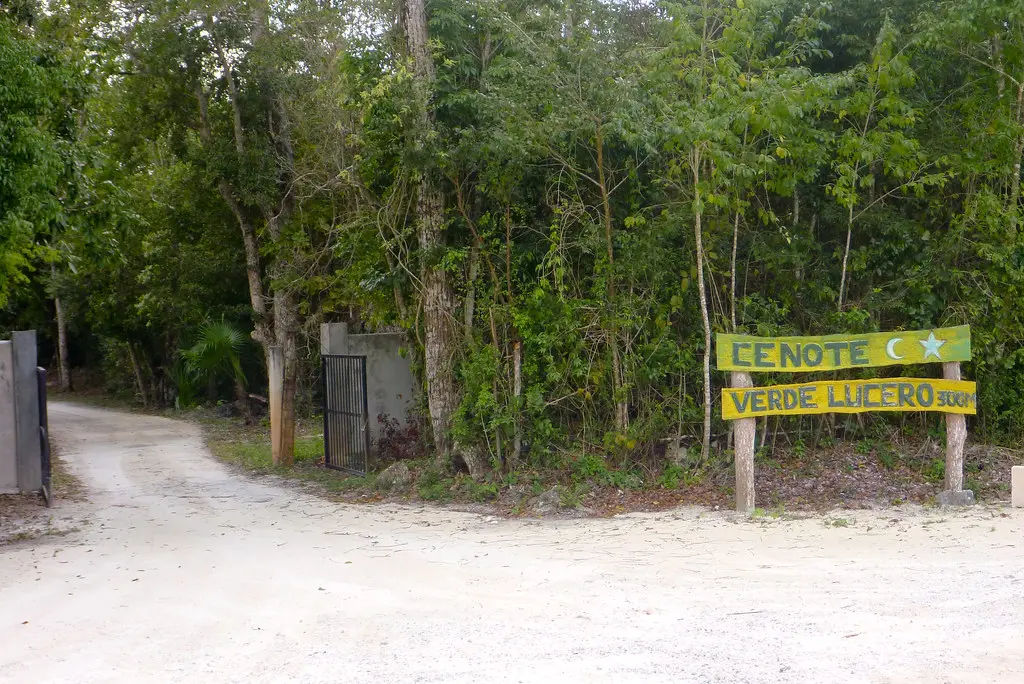
Over centuries, Verde Lucero remained hidden within the forest, visited mainly by locals who used its waters for survival and ritual. It wasn’t until the late 20th century, when the Ruta de los Cenotes began to open for eco-tourism, that it became a destination for swimmers and adventurers. Wooden steps and simple platforms were added, but the cenote retained its natural character—clear turquoise waters surrounded by vertical limestone walls and overhanging roots.
⭐⭐⭐⭐⭐ - Liz Canto
I love to visit this Cenote ,as it’s beautiful and it’s surroundings are calm by time to time ( they have tour groups that come and go like for 30 min , still fun to watch them jump to the water 🤭) , then they leave and it’s quiet.
As a local of puerto , I love to take my outsiders friends or family members , and every time I have visit it’s just a perfect day to enjoy the scenery and nature of the place .
They have a restaurant there , but if you want You can also take your own food and drinks they charge you $100 pesos to take them in .
9. Cenote Siete Bocas
Important Information
- Fun Fact: Named for its seven distinct entrances (“bocas”), this cenote system offers a mix of caves, swimming holes, and cliff-jumping spots.
- Address: Carretera Ruta de los Cenotes, km 15, Puerto Morelos, Q.R., Mexico
- Best time to visit: Late morning for good light inside the caverns.
- Distance to city center: About 14 miles west of Puerto Morelos.
- Pricing: Adults $20 USD; children $10 USD.
- Parking: Free on-site parking.
- Accessibility: Uneven terrain; not wheelchair accessible.
- Opening Hours: Daily 9 a.m.–5 p.m.
- Closing Hours: 5 p.m.
- Discounts / Deals: Group and local discounts available.
Hidden within the jungle outside Puerto Morelos, Cenote Siete Bocas takes its name from the seven natural openings, or “mouths,” that lead into its crystal-clear underground waters. These limestone caverns formed over thousands of years as part of the vast network of subterranean rivers that define the Yucatán Peninsula. For the Maya, cenotes like this were sacred, revered as both lifelines of freshwater and portals to the spiritual realm of Xibalba.
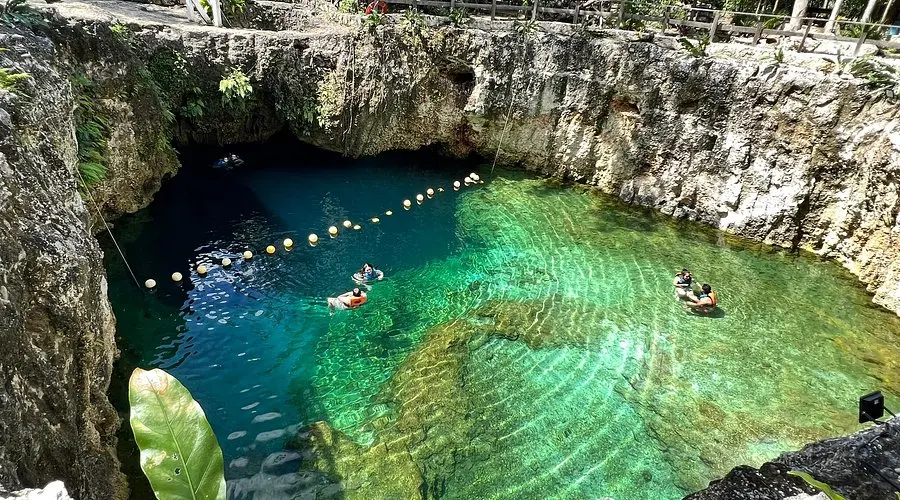
Local oral histories tell of families who drew water here long before paved roads connected the coast to the inland jungle. Each opening, whether narrow shaft or wide cavern, reveals a different face of the cenote—sunlit pools, hidden passages, and dramatic limestone formations that speak to millennia of geological change. Only in recent decades was Siete Bocas opened to visitors, as part of the Ruta de los Cenotes eco-tourism corridor, giving travelers access to a natural wonder once reserved for locals and explorers.
Swimming beneath its stone arches connects visitors with the same waters that sustained ancient communities. Siete Bocas is not simply an attraction but a living fragment of the Yucatán’s history, carrying forward traditions of reverence, survival, and discovery.
⭐⭐⭐⭐⭐ - Dale Burks
Cenote Siete Bocas was a fantastic experience. There was so much more to explore, but we just didn’t have time.
They have the main cenote where the photos show us enjoying the area. But there are many many many other places to explore here. There are more cenote to explore. There’s one with bats in it. It’s just a fantastic cenote to come and spend the day.
The people that work here are very friendly and hospitable. They give great guidance on where to go what to do how to spend your time.
Very easy to put together a picnic. It’s easy to spend the entire day here.
I recommend the cenote to everybody that comes because if it’s easy access, friendly people and fantastic experience overall .
10. Cenote La Noria (Entrada)
Important Information
- Fun Fact: Known for its crystal-clear turquoise water and natural light filtering through limestone openings, perfect for swimming and photography.
- Address: Carretera Ruta de los Cenotes, km 20, Puerto Morelos, Q.R., Mexico
- Best time to visit: Morning for best lighting conditions.
- Distance to city center: About 17 miles west of Puerto Morelos.
- Pricing: Adults $15 USD; children $10 USD.
- Parking: Free on-site parking.
- Accessibility: Wooden stairs and decks; not fully accessible.
- Opening Hours: Daily 9 a.m.–5 p.m.
- Closing Hours: 5 p.m.
- Discounts / Deals: Reduced pricing for locals and students.
Cenote La Noria lies deeper along the Ruta de los Cenotes, a site where history, geology, and local tradition converge. The entrance, known as la entrada, marks the point where visitors descend into one of the region’s most enchanting natural pools. For centuries, this cenote was known mainly to locals, who drew water from its depths and regarded it with respect as part of the sacred landscape of the Maya.
The name “La Noria” evokes the imagery of a waterwheel, a symbol of sustenance and continuity. In many ways, it reflects how cenotes functioned in daily life—sources of fresh water that made settlement in the Yucatán possible despite its lack of rivers. Archaeological evidence across the peninsula shows offerings and artifacts placed in cenotes, underscoring their role in both survival and spirituality.
It wasn’t until eco-tourism expanded in the late 20th century that Cenote La Noria was prepared for visitors, with stairways and simple platforms added. Yet the cenote retains its wild charm—sunbeams filtering through openings in the limestone ceiling, roots dangling toward clear waters, and echoes of the jungle above. It is both a natural wonder and a reminder of how ancient traditions continue to shape the region’s identity.
11. Mexican Artisan / Arts and Craft Market
Important Information
- Fun Fact: A vibrant market showcasing handmade crafts from across Mexico — pottery, textiles, jewelry, and traditional souvenirs.
- Address: Av. Javier Rojo Gómez, Puerto Morelos, Q.R., Mexico
- Best time to visit: Morning for best selection and cooler weather.
- Distance to city center: Located near the main square in Puerto Morelos.
- Pricing: Free entry; items $5–$200 USD depending on craftsmanship.
- Parking: Street and nearby lot parking available.
- Accessibility: Accessible walkways and entrances.
- Opening Hours: Daily 9 a.m.–6 p.m.
- Closing Hours: 6 p.m.
- Discounts / Deals: Negotiation common; bundle discounts available.
Though modest compared to the sprawling markets of Mérida or Cancún, the Mexican Artisan and Arts & Craft Market in Puerto Morelos reflects a tradition with roots stretching back to pre-Hispanic times. Markets were central to Mayan life, where communities gathered not only to exchange goods but also stories, rituals, and news. That cultural thread survived the colonial period, adapting through generations while preserving the artistry of handmade crafts.
This smaller market carries that same legacy. Stalls showcase pottery shaped with techniques passed down for centuries, textiles woven with regional patterns, and jewelry crafted from silver and local stones. Each piece reflects the heritage of artisans whose families have worked in these trades for generations. While Puerto Morelos is best known for its reefs and beaches, markets like this ensure that Mexico's cultural dimension is never overshadowed by tourism.
Even if it draws fewer crowds, the market plays an important role in keeping craft traditions alive. It offers visitors not just souvenirs, but tangible connections to the history of the Yucatán Peninsula—objects made by hand, infused with stories, and tied to practices that long predate the resort age of the Riviera Maya.
12. Boca del Puma
Important Information
- Fun Fact: An eco-adventure park in the jungle offering ziplining, ATV rides, cenote swimming, and a small natural history museum.
- Address: Carretera Ruta de los Cenotes, km 16, Puerto Morelos, Q.R., Mexico
- Best time to visit: Morning for cooler weather and fewer crowds.
- Distance to city center: About 14 miles west of Puerto Morelos.
- Pricing: Adults $70 USD; children $55 USD (includes activities).
- Parking: Free on-site parking.
- Accessibility: Limited due to rugged terrain.
- Opening Hours: Daily 9 a.m.–5 p.m.
- Closing Hours: 5 p.m.
- Discounts / Deals: Online booking discounts and group packages.
Deep in the jungle along the Ruta de los Cenotes lies Boca del Puma, a site where nature, history, and adventure intersect. The name, meaning “Mouth of the Puma,” evokes the wilderness that once dominated this region and still lingers in its dense forests. Long before the area was known to tourists, the caves and cenotes here were known to the Maya, who regarded them as sacred spaces and essential sources of freshwater. Archaeological evidence has revealed that cenotes in this region often served as ceremonial sites, where offerings were left for deities tied to rain and fertility.
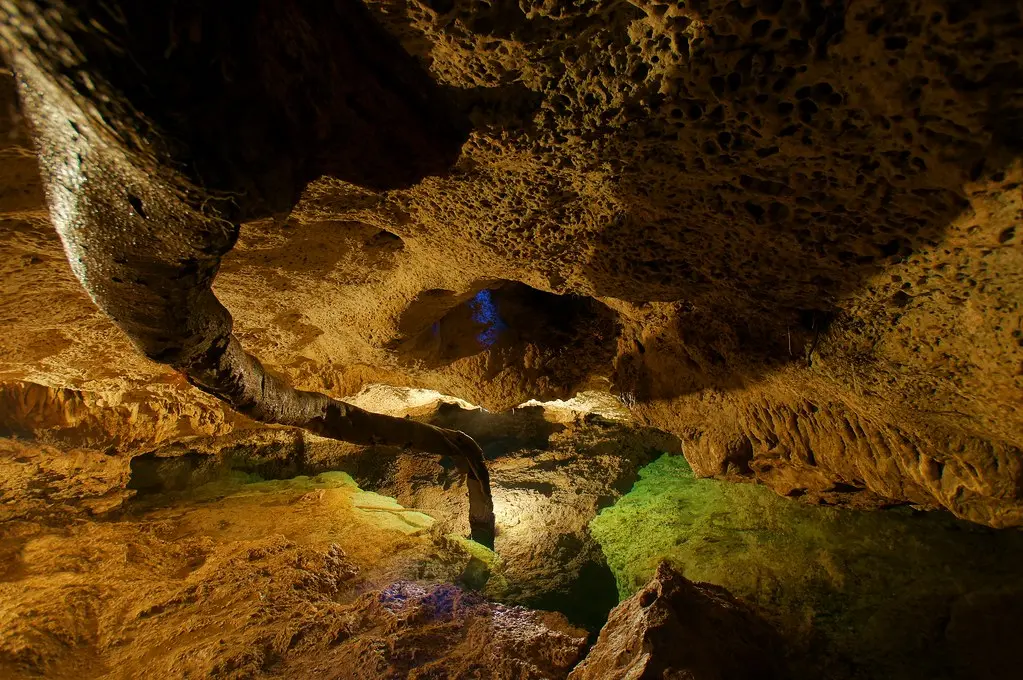
In the modern era, Boca del Puma became part of an eco-adventure park, with zip lines and trails added to complement the cenote experience. Yet at its core, the site retains the aura of antiquity. Beneath the thrill of outdoor activities lies a deeper layer of meaning: the limestone caverns and cenotes that sustained life in the Yucatán for centuries.
Visiting Boca del Puma is therefore not only about adrenaline but about continuity. The cenotes remain as timeless as ever, linking today’s eco-tourism with the sacred landscapes that guided the Maya. In every plunge into its waters, history and nature come together.
⭐⭐⭐⭐⭐ - Graham Kaplan
Booked an all day excursion that included Tulum, a visit to a Mayan village, a trip to Coba, and a stop at a cenote. Everything went down perfectly. I put down a deposit the day I booked the trip (3 days in advance, made the reservation in person), And I paid the rest the morning that we left. We were picked up on time and exactly at the location we were told to meet at. The excursion was well organized from start to finish and The guides were extremely knowledgeable and friendly. I would 100% book with them again
13. Cenote La Noria
Important Information
- Fun Fact: A scenic cenote within a cavern, featuring stalactites, turquoise waters, and swimming decks for a peaceful jungle escape.
- Address: Carretera Ruta de los Cenotes, km 20, Puerto Morelos, Q.R., Mexico
- Best time to visit: Mid-morning for best light inside the cave.
- Distance to city center: About 17 miles west of Puerto Morelos.
- Pricing: Adults $15 USD; children $10 USD.
- Parking: Free on-site parking.
- Accessibility: Stairs and uneven terrain; not wheelchair accessible.
- Opening Hours: Daily 9 a.m.–5 p.m.
- Closing Hours: 5 p.m.
- Discounts / Deals: Discounts for locals and tour groups.
Among the cenotes of Puerto Morelos, Cenote La Noria holds a reputation for both beauty and heritage. Hidden within dense jungle, it belongs to the network of freshwater sinkholes that sustained the Maya for centuries. These cenotes were not simply swimming holes—they were lifelines. In a land without rivers, they provided water for crops, rituals, and daily survival. Many were also sacred sites, believed to be gateways to the spiritual underworld, Xibalba.
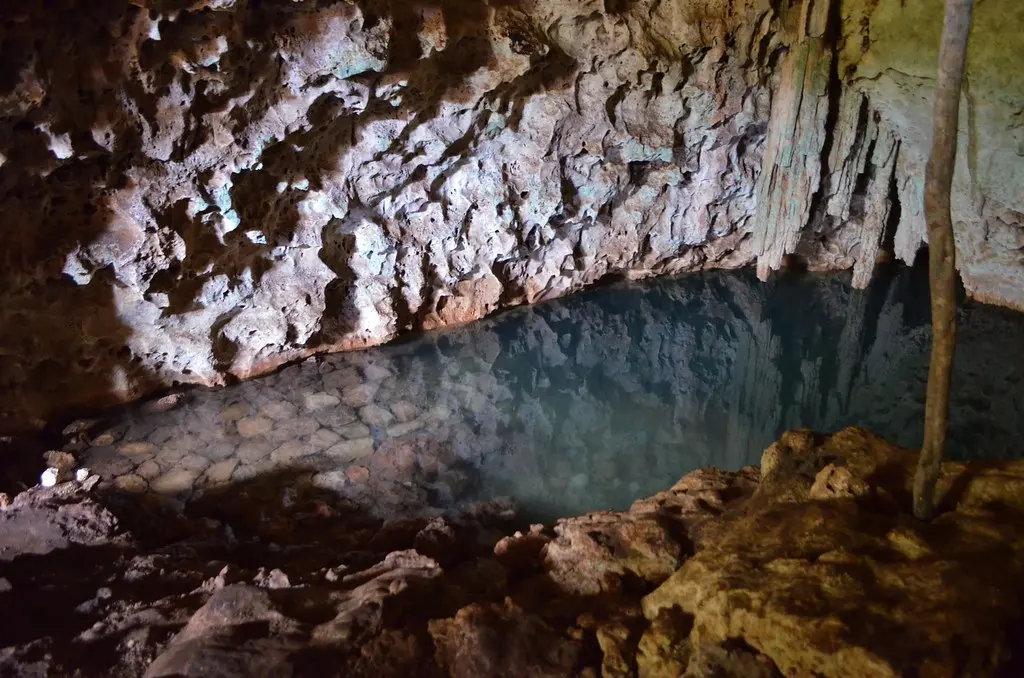
La Noria reflects that layered past. Its cavernous interior, lit by shafts of sunlight filtering through limestone openings, evokes the atmosphere of an ancient ceremonial chamber. Roots of jungle trees plunge down toward its clear waters, a reminder of how nature and time carved this space over millennia. Archaeological findings across the Yucatán suggest that cenotes like La Noria once held offerings, linking them directly to the spiritual fabric of Mayan life.
In more recent history, La Noria became part of the Ruta de los Cenotes, joining other natural pools that were opened to eco-tourism in the late 20th century. Simple platforms and steps have made it accessible, but its essence remains untouched. Swimming here offers not just refreshment, but a chance to step into the same waters that defined civilizations long before Puerto Morelos became a modern destination.
⭐⭐⭐⭐⭐ - Sergei Grozenok
We visited La Noria Cenote as a family with two kids, arriving right at opening time, and had the whole place to ourselves. In the middle of the cenote, there’s a wooden platform where you can jump into the water or enjoy the swings, such great fun for all of us. It’s a beautiful spot right in the heart of the jungle, with two entrances: one wide with steps and another narrow, cave-style entrance for a more adventurous feel. Life vests are available if you want them. There’s also a cafe and bar nearby, plus horse riding on offer for an extra charge. We absolutely loved it and would definitely recommend a visit.
Interactive Map
Where to Eat in Puerto Morelos
| Restaurant | Address | Phone | Notable Dish / Specialty |
|---|---|---|---|
| John Gray’s Kitchen | Avenida Niños Héroes SM2 M6 L14, Puerto Morelos, Q.R. | +52 998 871 0665 | Contemporary cuisine; fish, chicken, duck, creative plating |
| Punta Corcho | Across from La Sirena, Puerto Morelos | +52 998 317 7658 | Mexican regional cuisine & seafood; rooftop views |
| Tanino’s | Avenida Javier Rojo Gómez, Puerto Morelos, Q.R. | +52 998 846 1877 | Mexican + Mediterranean fusion, wine list, romantic setting |
| Boquinete Seafood & Grill | Puerto Morelos, Q.R. | (phone not confirmed) | Seafood, ceviche, fresh fish, beachfront setting |
| La Sirena | Calle José María Morelos S/N, Puerto Morelos, Q.R. | +52 998 293 2671 | Mediterranean / Greek influences, rooftop bar, live music |
| La Pepita | Rafael E. Melgar S/N, SM2 MZ4, Puerto Morelos, Q.R. | +52 998 206 9109 | Seafood & Mexican fare; casual oceanfront dining |
| El Campanario | Puerto Morelos, Q.R. | (phone not confirmed) | Steaks & Argentine cuisine, favorite among expats |
Puerto Morelos Vs Neighboring Cities
| Metric | Puerto Morelos | Cancún | Playa del Carmen |
|---|---|---|---|
| Population (2020–2025 est.) | ~27,000 | ~888,000 | ~305,000 |
| Vibe & Character | Tranquil coastal town with authentic Mexican charm and strong local community | Large resort city known for nightlife, high-rise hotels, and heavy tourism | Trendy, cosmopolitan beach city popular with digital nomads and tourists |
| Cost of Living / Housing | More affordable housing and groceries; moderate rental prices near the beach | High housing costs, especially in hotel and resort zones | High demand for rentals and condos, expensive in the tourist center |
| Tourism & Attractions | Reef diving, snorkeling, cenotes, nature parks, and small local restaurants | Nightclubs, major resorts, theme parks, and white-sand beaches | Shopping on Quinta Avenida, beach clubs, nightlife, and nearby Cozumel ferries |
| Growth & Development | Steady but moderate development; retains a small-town identity | Rapid urban expansion and infrastructure growth | Fast condominium and tourism development, high population growth |
| Accessibility | 30 minutes south of Cancún, 30 minutes north of Playa del Carmen | Home to the main international airport in the region | Connected via Highway 307 and Cozumel ferry terminal |
| Median Age | ~34 years | ~32 years | ~30 years |
| Primary Economy | Tourism, fishing, small-scale trade, eco-lodging | Tourism, hospitality, events, and retail | Tourism, hospitality, digital nomads, and real estate |
| Vibe & Lifestyle | Peaceful, authentic, family-friendly with a slower pace of life | Energetic, fast-paced, and entertainment-driven | Trendy, international, vibrant, with a mix of cultures and nightlife |
How to get to Puerto Morelos
By Air
- You’ll fly into Cancún International Airport (CUN) — the closest major airport to Puerto Morelos.
- From CUN, Puerto Morelos is about 20-25 minutes south by road (distance ~ 18–21 km), depending on your destination and traffic.
By Car / Shuttle / Taxi
- Many travelers book shared or private shuttles from Cancun Airport to Puerto Morelos.
- A private transfer from the airport to a hotel in Puerto Morelos typically costs around USD $50-$60 (varies by provider).
- Taxis and pre-arranged vans are available, though ride-share services like Uber may have restrictions in that region.
By Bus / Public Transport
- The ADO bus system connects Cancun with other towns. However, the direct ADO airport bus no longer stops in Puerto Morelos. Passengers must change at the ADO terminal in Cancun and catch a local bus toward Puerto Morelos.
- Local colectivos (shared vans) run between Puerto Morelos and nearby towns (for instance, Leona Vicario) along the “Ruta de Cenotes.”
By Train (Tren Maya)
- Puerto Morelos now has a station on the Tren Maya line, which connects it to Cancún and Playa del Carmen.
- The Tren Maya route is a good option if schedules align, though road transport is still the main connection for many travelers.
Conclusion
The story of Puerto Morelos is written across its landscapes. In the jungle, cenotes whisper of the Maya who once regarded them as sacred portals. Along the shore, the reef continues to guard the coast as it has for centuries, now protected by those whose ancestors once fished its waters. Markets and gardens, small in scale but rich in meaning, carry forward traditions of craftsmanship and conservation that anchor the town’s identity.
What unites these places is continuity. Every cenote, every market stall, every wave breaking on the public beach ties the present to a past that is never far from view. Puerto Morelos did not chase the towering resorts or neon spectacle of its neighbors; instead, it preserved a rhythm closer to its roots. Visitors who come here step not only into attractions but into the living history of the Riviera Maya.
Exploring these 13 sites offers more than a checklist of epic things to do in Puerto Morelos, Mexico's Maya Jewel. It is an invitation to see how heritage and nature endure side by side, shaping a town that has never lost its soul.
FAQ
1. What are the must-do activities in Puerto Morelos for a short visit?
If you only have a couple of days, start with the town’s most iconic attractions — snorkeling on the Mesoamerican Reef (one of the world’s largest), visiting the leaning lighthouse by the beach, and enjoying fresh seafood at local spots like La Sirena or El Merkadito. Explore the artisan shops in the town square, rent a bike, and stop by the small but charming Farmers Market if it’s open. Don’t skip a cenote adventure — Ruta de los Cenotes nearby offers dozens of natural swimming holes surrounded by jungle.
2. What can I expect if I’m visiting Puerto Morelos for a week?
A week in Puerto Morelos gives you time to relax and explore beyond the beach. Spend a few mornings snorkeling or diving, then check out local cenotes such as Cenote Verde Lucero or Kin Ha. You can take day trips to Playa del Carmen, Isla Mujeres, or the Mayan ruins in Tulum. Evenings are best spent enjoying local live music, trying authentic Yucatán cuisine, and walking the peaceful seaside promenade. Puerto Morelos has a laid-back charm — think hammocks, ocean breeze, and friendly locals, far quieter than Cancun or Playa.
3. Is Puerto Morelos worth visiting compared to Cancun or Playa del Carmen?
Absolutely — especially if you prefer calm, authenticity, and a slower pace. While Cancun and Playa del Carmen are packed with resorts, nightlife, and crowds, Puerto Morelos keeps a small-town Caribbean vibe. It’s ideal for travelers who want turquoise water, snorkeling, and good food without loud party scenes. Many travelers describe it as “how Playa del Carmen used to feel 20 years ago.” You’ll still have access to great tours, comfortable accommodations, and reliable Wi-Fi, but the community here is more relaxed and welcoming.
4. How do I get from Puerto Morelos to Cancun?
Getting to Cancun from Puerto Morelos is easy. The town sits about 35 km (22 miles) south of Cancun Airport. You can take a shared van (colectivo) for around $2–3 USD, a bus from the ADO station, or hire a private taxi, which costs roughly $35–40 USD. Travel time averages 25–35 minutes. Uber and Didi may not always operate legally in the area, so taxis or private transfers are the safest bet. If you’re going to Cancun just for a day trip, most resorts and local agencies can arrange round-trip transfers easily.
5. Where are the best places to stay near the town center?
To experience the real Puerto Morelos, choose accommodations near the town square or beachfront — you’ll be within walking distance of restaurants, shops, and the fishing pier. Boutique hotels like Hotel Amar Inn, Casa Caribe, and The Fives Oceanfront are favorites for their comfort and charm. Vacation rentals are also popular for long stays. If you prefer luxury and privacy, stay in a beachfront resort along the Riviera Maya strip, but note that many of those are several miles from the actual town center.
6. Do things stay open during the off-season (September–October)?
Yes, but with reduced hours. September and October are part of the hurricane and rainy season, so tourism slows down. Some restaurants and excursion companies temporarily close for maintenance, but most essential services remain open. You’ll find smaller crowds, lower hotel rates, and a more local atmosphere. The reef, cenotes, and beaches are still accessible, though tours may reschedule due to weather. It’s a great time to visit if you prefer peace and don’t mind occasional showers — just keep an eye on tropical storm forecasts.


